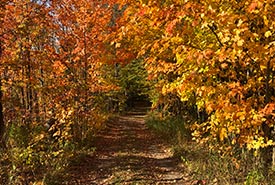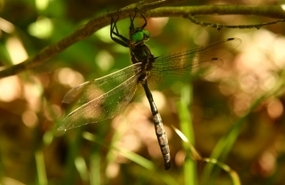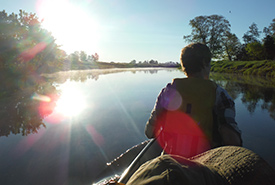Baldwick Bluff

Baldwick Bluff, Minesing Wetlands, ON (Photo by NCC)
One of southern Ontario’s largest wetlands
Just 15 kilometres west of Barrie lies one of the largest and least disturbed wetlands in southern Ontario. Comprising approximately 11,000 hectares (27,000 acres) of wetlands, fields and forests, the Minesing Wetlands are often referred to as the “Everglades of the North” due to their designation as a Ramsar Wetland of International Importance — a distinction they share with their Floridian counterpart.
An important meeting place of multiple watercourses, including the Mad River, Willow Creek and Nottawasaga River, the Minesing Wetlands play an important role in filtering the water that flows into Georgian Bay, and flows out of thousands of taps in nearby homes. This vast collection of marshes, fens and treed swamps acts as a large sponge to help mitigate floods and supports more than 30 at-risk species, including least bittern and cerulean warbler.
With an increase in storm events, and dramatic changes in precipitation levels and patterns caused by the climate crisis, protecting wetlands has never been more important. To ensure clean drinking water and dry basements for humans, as well as homes for insects like the Hine’s emerald dragonfly, an extremely rare insect found only in the Minesing Wetlands in Canada, we need to act now to conserve large, intact wetlands like Minesing.

Hine's emerald dragonfly at Minesing Wetlands, ON (Photo by Chris Evans)
In 2020, the Nature Conservancy of Canada (NCC) purchased 32 hectares (80 acres) of forests, fields, wetlands and headwater streams surrounding the core of the Minesing Wetlands. The area acts as a protective buffer to the main wetlands — ensuring wildlife have the room they need to thrive, and assisting in controlling floods and providing clean water for nearby communities. NCC's future plans for the site include restoring former farm fields to forest or native meadow, increasing wildlife, especially pollinator, habitat.
Quick facts
Location: Springwater, 10 minutes west of Barrie, Ontario
Habitat type: Ravine forests, meadow marshes, open fields, headwaters streams and moist cedar forests
Size: 32 hectares (80 acres)
Species: Hine’s Emerald dragonfly, eastern meadowlark, bobolink, white-tailed deer
Minesing Wetlands: A priority for conservation

Minesing Wetlands bioblitz, ON (Photo by NCC)
The Minesing Wetlands are one of NCC’s oldest active natural areas. Since 1974, NCC and our partners have protected over 5,500 hectares (13,600 acres) of conservation lands, many of which are now owned and managed by NCC’s primary partner on the landscape: the Nottawasaga Valley Conservation Authority.
This Provincially Significant Wetland and Area of Natural and Scientific Interest supports a wide variety of wetland birds and waterfowl, which flock to the area in the tens of thousands during spring migration when most of the wetlands resemble a large lake. These species-rich wetlands are also important in providing flood control, water filtration, fish habitat and recreational opportunities. Over 70 per cent of southern Ontario’s wetlands have been converted to alternative uses since European settlement. The remaining wetlands are threatened by non-native invasive plant species, pollution and habitat fragmentation.
For more than 45 years, NCC and our partners have delivered restoration and protection programs, including reforestation, stream bank stabilization, erosion control and nutrient management projects, and invasive species control. These projects help reduce and sequester phosphorus, improve streamside shading and create habitat for many native species. Since 2010, NCC and our partners have restored approximately 25 hectares (61 acres) of deciduous swamp forest, buffered 12 kilometres of rivers and streams and controlled 3 hectares (8 acres) of invasive species in the Minesing Wetlands Natural Area




